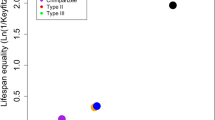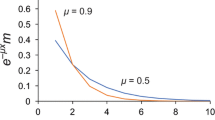Abstract
The catastrophic senescence of the Pacific salmon is among the initial tests used to validate the Penna aging model. Based on the mutation accumulation theory, the sudden decrease in fitness following reproduction may be solely attributed to the semelparity of the species. In this work, we report other consequences of mutation accumulation. Contrary to earlier findings, such dramatic manifestation of aging depends not only on the choice of breeding strategy but also on the value of the reproduction age, R, and the mutation threshold, T. Senescence is catastrophic when \(T \le R.\) As the organism’s tolerance for harmful genetic mutations increases, the aging process becomes more gradual. We observe senescence that is threshold dependent whenever T > R. That is, the sudden drop in survival rate occurs at age equal to the mutation threshold value.






Similar content being viewed by others
References
Buffenstein R (2008) Negligible senescence in the longest living rodent, the naked mole-rat: insights from a successfully aging species. J Comp Physiol B 178:439–445
Coleman B, Hsieh YH (1979) Theory of the dependence of population levels on environmental history of semelparous species with short reproductive seasons. Proc Natl Acad Sci USA 76:5407–5410
Crespi B, Teo R (2002) Comparative phylogenetic analysis of the evolution of semelparity and life history in salmonid fishes. Evolution 56:1008–1020
Dabkowski J, Groth M, Makowiec D (2000) Verhulst factor in the Penna model of biological aging. Acta Phys Polonica B 31:1027–1035
Finch C (1990) Longevity, senescence and the genome. University of Chicago Press, Chicago
Malarz K (2000) Searching for scaling in the Penna bit-string model for biological ageing. Int J Mod Phys C 11:309–315
Meyer-Ortmanns H (2001) Catastrophic senescence of the Pacific salmon without mutation accumulation. Int J Mod Phys C 12:319–323
Moss de Oliveira S (1998) A small review of the Penna model for biological ageing. Physica A 257:465–469
Moss de Oliveira S (2004) Evolution, ageing and speciation: Monte carlo simulations of biological systems. Braz J Phys 34:1066–1076
Niewczas E, Kurdziel A, Cebrat S (2000) Housekeeping genes and death genes in the Penna aging model. Int J Mod Phys C 22:775–783
Partridge L, Barton N (1993) Optimality, mutation and the evolution of aging. Nature 362:305–311
Penna TJP (1995) A bit-string model for biological aging. J Stat Phys 78:1629–1633
Penna TJP, Stauffer D (1995) Efficient Monte Carlo simulation of biological aging. Int J Mod Phys C 6:233–239
Penna TJP, Moss de Oliveira S, Stauffer D (1995) Mutation accumulation and the catastrophic senescence of the Pacific salmon. Phys Rev E 52:R3309–R3312
Puhl H, Stauffer D, Roux S (1995) Ageing, wars and predators. Physica A 221:445–452
Quinn T (2005) The behavior and ecology of Pacific salmon and trout. University of Washington Press, Canada
Ricklefs R (2008) The evolution of senescence from a comparative perspective. Funct Ecol 22:379–392
Sá Martins JS, Cebrat S (2000) Random deaths in a computational model for age-structured populations. Theory Biosci 119:156–162
Sá Martins JS, Moss de Oliveira S (1998) Why sex?—Monte Carlo simulations of survival after catastrophes. Int J Mod Phys C 9:421–432
Smith F, Charnov E (2001) Fitness trade-offs select semelparous reproduction in an extreme environment. Evol Ecol Res 3:595–602
Vaupel J, Missov T, Metcalf C (2008) Optimal semelparity, http://ideas.repec.org/p/dem/wpaper/wp-2008-012.html. Accessed 24 Aug 2010
Author information
Authors and Affiliations
Corresponding author
Rights and permissions
About this article
Cite this article
Piñol, C.M., Banzon, R. Catastrophic senescence and semelparity in the Penna aging model. Theory Biosci. 130, 101–106 (2011). https://doi.org/10.1007/s12064-010-0115-7
Received:
Accepted:
Published:
Issue Date:
DOI: https://doi.org/10.1007/s12064-010-0115-7




